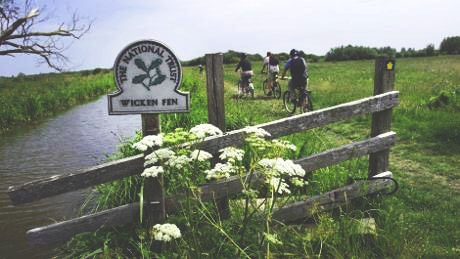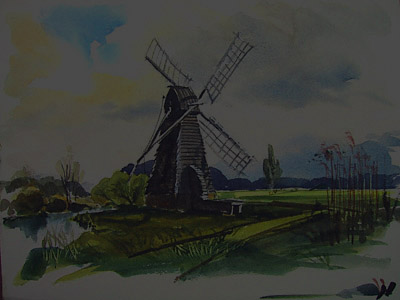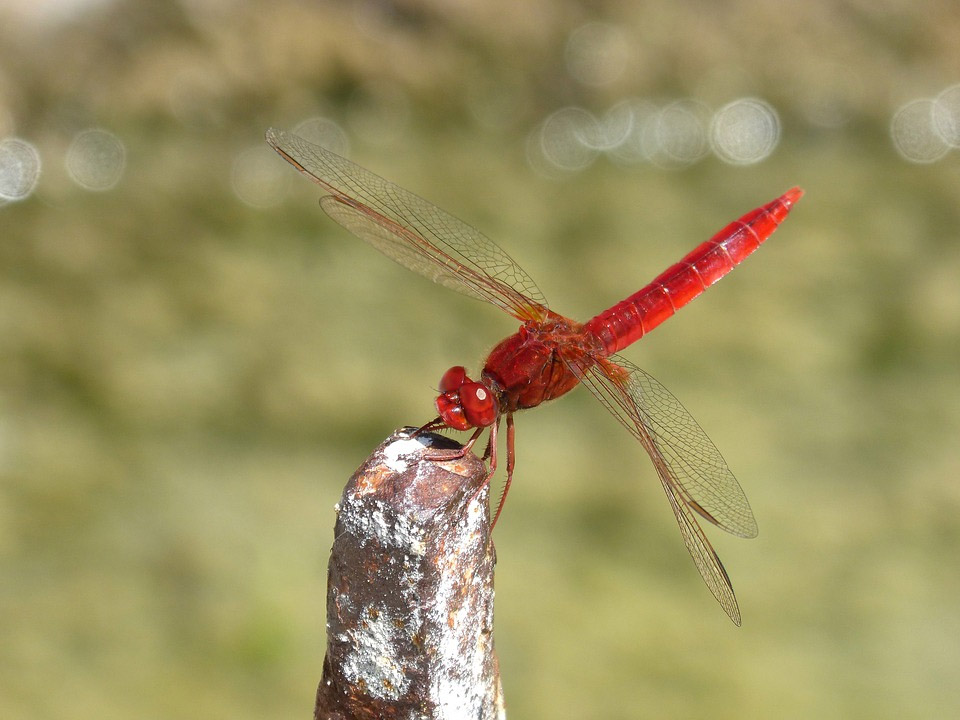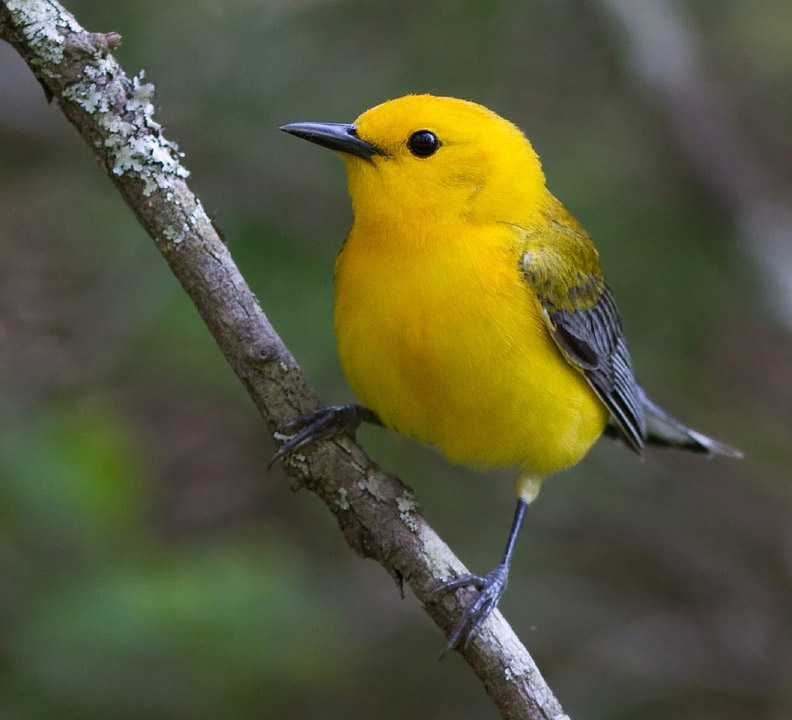National Trust
The marshes of Wicken Fen, which straddles Cambridgeshire and Bedfordshire, include the Wicken Fen National Nature Reserve, which has been in the care of the National Trust since 1899 and is the Trust’s oldest nature reserve.
Founded in 1895, the National Trust are now the largest environmental charity in Europe with landholdings totalling over 250,000 hectares in England, Wales and Northern Ireland. The Trust has 3.6 million members and an annual turnover in excess of £160 million and endowed assets exceeding £70 million.

History
Wicken Fen National Nature Reserve currently covers 785 hectares and has a number of important designations that include: National Nature Reserve, and Site of Special Scientific Interest (national designations); a Special Area of Conservation (European designation) and a Ramsar Site (an international wetland designation).
The straight, raised waterways that cross the area to the south of Wicken may be of Roman origin, used to transport goods to the River Cam and from there up to King's Lynn. The later medieval period saw some localised drainage at the fen edge that produced grazing land. In the seventeenth century the land was drained and transformed into intensively farmed countryside that continues today.
Yet the area known as Wicken Fen always remained undrained and was used for peat digging and sedge harvesting by local villagers. It became popular from the mid-nineteenth century with Victorian naturalists. A young Charles Darwin collected beetles here in the 1820s, while the fathers of modern ecology and conservation, Cambridge botanists Sir Harry Godwin and Dr. Arthur Tansley, would later carry out their pioneering work here.
In the 1890s when the peat and sedge economies collapsed, Charles Rothschild, of the banking dynasty, and a passionate entomologist, purchased 2 acres of the Fen for £10 and donated them to the National Trust.
Wicken Fen Vision
In 1999, the National Trust launched the “Wicken Fen Vision”, an ambitious 100-year, landscape-scale conservation project to extend the reserve from Wicken south towards the outskirts of Cambridge, covering an area of 5300 sq hectares. The aim is to create a mix of wetland habitats to include wet grasslands, reed beds, marsh, fen and shallow ponds and ditches, as well as establishing chalk grassland and woodlands. These new areas all help to protect the existing Wicken Fen National Nature Reserve, which is one of the most important in Europe.
As it is not possible to manage newer areas of the reserve in such an intensive manner as the ancient heart of the fen, the restoration has three key elements.
These are: natural regeneration of plants; reducing the loss of water through field drains and ditches, and the use of grazing animals. Grazing animals will help wetland and grassland plants to become established in new areas of the nature reserve.
The introduction of grazing herds of Highland cattle originating in Scotland, and Eastern European Konik ponies, are helping to create these new habitats. These are hardy breeds, capable of thriving on fenland all year round, plus they have a placid nature. Their impact on vegetation will vary, with some areas grazed more heavily than others. Their introduction to the reserve will also attract new species of flora and fauna to the fen, through their well trodden paths in areas of long grass, dusty hollows where they roll and their dung.
When horses graze they eat selected plants leaving short, cropped grass. Cattle tear at vegetation and leave a rougher landscape.
These grazing styles complement each other for the long term management of Wicken’s new areas of nature reserve.
The construction of a bridge to link Baker’s Fen and Harrison’s Farm fulfils part of Wicken Fen’s land management plan to allow the grazing animals to roam freely across a much larger area. The bridge was opened in Spring 2017. In time, the areas where clay has been excavated for use in the construction of the bridge, will provide excellent habitats for wildlife.
Future plans at Wicken Fen are to link Adventurers' Fen to Burwell Fen via a new crossing over Burwell Lode. This will not only open up another vast grazing area in the nature reserve, but will be segregated to form part of the Lodes Way, (National Cycle Route 11), linking Ely to Bottisham.
The Wicken Fen Vision, together with the Great Fen Project near Peterborough will form part of a new network of wetland habitats across the East of England, helping conserve species at risk from the loss of freshwater coastal habitats and from climate change.
The conservation integrates the needs of wildlife with the needs of local people, the economy and tourism. Wicken Fen has a wild camp-site, where the four shelters are log boxes raised off the ground. The toilet is a long-drop among the trees. To help children reconnect with nature, the National Trust has put together a free booklet of “50 things to do before you’re 11¾”.
There is also a rich cultural heritage across the Wicken Fen Vision area with more than 400 archaeological sites including three Scheduled Ancient Monuments and 44 listed buildings.
Wind pump
Wicken Fen's iconic wind-pump stands on the edge of Sedge Fen, a reminder of the former peat digging industry which was once widespread in the Fens. Before the advent of steam and diesel pumping engines, wind power was the major force enabling drainage of turf pits and fields. Restored in 1956, today the wind-pump pumps water from a nearby ditch onto Sedge Fen.

Fen Cottage
Fen cottage, constructed from local materials including peat, wood, sedge, reed and clay in various stages from the late eighteenth century to the early twentieth century, was originally two separate cottages until 1925. Four generations of the Butcher family lived in the house, the last residents being Alice and her son Reggie who lived in the cottage until 1972. The National Trust acquired the cottage in 1974 and began restoration in 1988, using local materials and techniques that would have been used in its original construction.
Fenman's Workshop
A recreation of a typical 1930's Fenman's workshop, the workshop provides details as to how Fenlanders lived and worked, including sedge and reed harvesting, peat digging, eel catching, willow working and more.

Ancient Sedge Fen
Today, Wicken is one of the last remaining fragments of sedge fen in Europe. The ancient Sedge Fen, lying in the heart of Wicken Fen Reserve is managed using traditional principles, but modern techniques that include harvesting sedge, litter cutting (marsh hay) and scrub management.
At 255 hectares in the mid twentieth-century, the designated National Nature Reserve was too small to guarantee the long-term survival of all of its numerous rare and special species. The only way to make a significant long-term difference for nature, according to the Trust, was to increase the size of the reserve, but linking it with other areas where the countryside is sympathetic.
The Future
The Wicken Fen Vision provides an opportunity to create self-regenerating habitats that can be managed less intensively and will be more responsive and adaptable to long term environmental change.
The National Trust has identified 53 square kilometres of land that could form part of the Wicken Fen Vision and are looking at the possibility of management agreements with landowners.
The Wicken Fen Vision and the Great Fen Project are pioneering landscape-scale projects in the UK. Experiences from both these projects will be shared in the future to influence policy development and practice in sustainable land management, habitat restoration and community engagement. Over the past 50 years, more than 250 academic papers have been published on various aspects of Wicken Fen.
Types of reserves
There are several types of reserves. These are locations that receive protection due to their natural, ecological or cultural value. Protected areas are vital for biodiversity conservation, often providing habitat and protection from hunting for threatened and endangered species. Protection helps maintain ecological processes that cannot survive in most intensely managed landscapes and marine areas.
Read moreNative American Reserve's Tourism
Tourists are able to visit Indian reservations, though some may require visitor registration at the tribal office. Photography may not be permitted on some reservations. There is usually little to see in native Indian reserves, since only a small minority of natives live in the traditional dwellings of their ancestors. The Indian pueblos in New Mexico and Arizona are the rare exception where some of the native peoples still live in the ancient adobe communal buildings of their ancestors. On these sites, and in some others, tribes have built visitor centres, museums, stores or casinos on their reservations to which tourists are invited.
Read More
Species
One of Europe’s most important wetlands, Wicken Fen has recorded more than nine-thousand species, including rare butterflies, dragonflies, birds and plants. Members of the public can view the fens via a series of raised board-walks and grass paths that provide easy access to flowering meadows, sedge and reed-beds. Here it is possible to hear and sometimes see bitterns and cuckoos. In summer rare orchids and...
Read more





